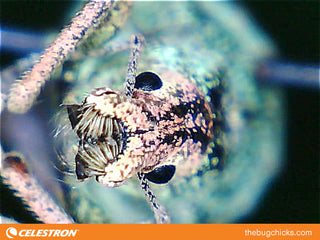Wings (Part One)
January 31, 2016
I was looking over my favorite Infiniview microscope shots and I found this scarab beetle elytra picture from my first time playing with it. It got me thinking about wings in all their different forms. I popped open a teaching collection of ours that needed to be cleaned up a bit and started snapping some shots of different kinds of wings. I took quite a few so we’ll do this in two parts.
When people think of insects wings, the impression I get from drawings or descriptions is either that of a butterfly with lots of colors or a clear nondescript wing. So in the next two posts I want to explore some of the diversity of structures found on insect wings.
#1
Below is a little treehopper. These small bugs are very difficult to see when they hop and fly and their wings are usually mottled with different colors. The wings are pitched over the back and meet at an angle in the shape of a little old-fashioned boy scout tent. So… as you can see on the pinned specimen below, it’s just a tiny brown and white-ish insect. Booooring. (Also the kind of bad non-macro shot is on purpose because this is about as much detail as you can see when looking at the bug with your naked eye.)
But under the scope it is a SUPERSTAR!!! I focused on the forewing section where the cream color meets the brown. The forewings of treehoppers are sclerotized which means they are hardened. This is different from say a dragonfly wing that is flexible and clear. Look at this! The metallic sheen! The sculpture! The punctate markings (pores)! I think this is one of my favorite shots I’ve ever taken. The cream color on the top is so gorgeous. And just when you think it’s a little brown bug- you can see all of the colors that go into the markings on an insect.
#2
Bees, ants and wasps are in the family Hymenoptera. ‘Hymen’ means membrane and -ptera means wing, so these are the membraneous winged insects. They are named that because they have wings that have very few veins compared to other insects. The wings of this wasp look pretty simple with a few veins and an amber tinge.
A closer look reveals tiny hairs on the surface of the wings! The tiny, scattered hairs are called microtrichia. Most insects have this feature on their wings, but without a scope you’d never see it!
I took the scope photos in this post with the Celestron Infiniview. Its a great option for stable and still subjects. I even did a little bit of fake-ish focus stacking here. For these two shots I just did a simple blending of two different photos where the areas of focus were slightly different. There are lots of photo stacking apps out there, but I’m still looking for one that I think will be perfect for teachers. I like free, easy and effective. It’s an uphill battle. When I find one I love I’ll highlight it here!































